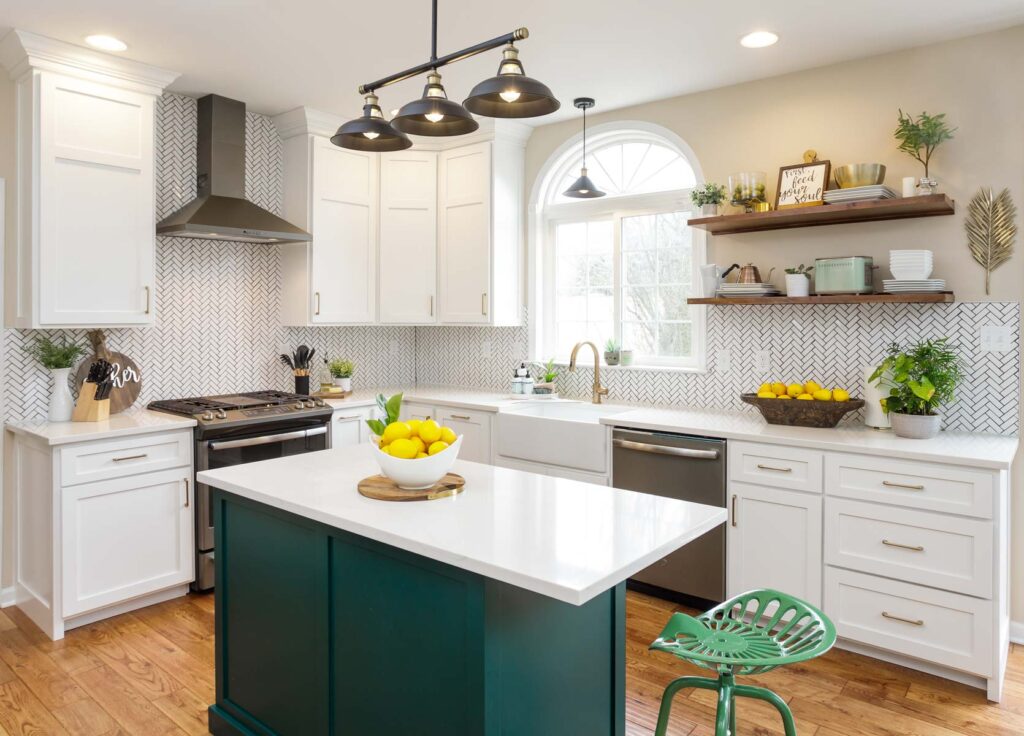Hershey residents are transforming their kitchens through professional lighting design that creates both functional workspaces and inviting gathering areas. The community’s mix of traditional Pennsylvania architecture and contemporary home designs requires lighting solutions that complement existing design elements yet provide modern functionality and energy efficiency. Professional lighting installation ensures proper electrical connections, strategic fixture placement, and seamless integration with kitchen layouts.
Lancaster Kitchens and Baths provides comprehensive kitchen lighting installation services throughout the Hershey area, delivering expert design consultation and professional installation that transforms ordinary kitchens into well-illuminated culinary spaces. Our experienced team understands how proper lighting enhances both the beauty and functionality of kitchen environments.
Recessed Lighting Solutions for Modern Kitchens
Recessed lighting provides clean, unobtrusive illumination that works particularly well in Hershey kitchens with lower ceilings or contemporary design themes. Professional installation requires careful planning to avoid structural elements including joists, ductwork, and electrical systems. Proper spacing creates even light distribution that eliminates dark spots and shadows throughout kitchen work areas.
LED recessed fixtures offer superior energy efficiency and longevity compared to traditional incandescent options. Advanced dimming capabilities allow homeowners to adjust lighting levels for different activities and times of day. Professional installation ensures proper heat management and electrical connections that maximize fixture lifespan and safety.
Trim selection affects both appearance and light distribution characteristics, with options including baffle, reflector, and adjustable trims that provide different lighting effects. Professional guidance helps homeowners select trim styles that complement kitchen design themes yet provide optimal functionality. Color temperature selection impacts the warmth and ambiance of kitchen lighting throughout different times of day.
Pendant Light Installation and Design
Pendant lighting creates focal points over kitchen islands, peninsulas, and dining areas yet provides functional task illumination for food preparation and cooking activities. Professional installation requires careful consideration of ceiling height, island dimensions, and surrounding design elements to achieve balanced proportions and optimal functionality. Proper electrical rough-in work ensures safe, code-compliant installations.
Scale and proportion considerations become critical when selecting pendant fixtures for specific kitchen layouts. Professional designers evaluate room dimensions, cabinet heights, and sight lines to recommend pendant sizes and hanging heights that enhance rather than overwhelm kitchen spaces. Multiple pendant installations require careful spacing and alignment for maximum visual impact.
Pendant style selection ranges from industrial and contemporary designs to traditional and transitional options that complement diverse kitchen aesthetics. Professional consultation helps homeowners select fixtures that coordinate with cabinet hardware, plumbing fixtures, and other design elements. Custom pendant installations can create unique lighting solutions that reflect personal style preferences.
Under-Cabinet Lighting Systems
Under-cabinet lighting eliminates shadows on countertop work surfaces yet provides ambient illumination that enhances kitchen atmosphere during evening hours. Professional installation includes proper wire management and transformer placement that conceals electrical components yet maintains easy access for maintenance. LED strip lighting offers flexibility and efficiency for various cabinet configurations.
Task lighting requirements vary based on countertop depth, upper cabinet configuration, and primary kitchen activities. Professional design considers these factors to position lighting systems that maximize functionality without creating glare or hot spots. Color temperature selection affects food preparation visibility and coordinate with other kitchen lighting elements.
Installation timing coordinates with kitchen renovation schedules to ensure proper access for wiring and mounting procedures. Professional installers work with cabinet manufacturers and contractors to integrate lighting systems seamlessly into kitchen designs. Kitchen lighting solutions in Elizabethtown PA explains how professional installation enhances both function and aesthetics.
Chandelier Installation for Dining Areas
Kitchen chandeliers create elegant focal points over dining tables and breakfast nooks yet provide ambient lighting that enhances the social aspects of kitchen environments. Professional installation requires adequate ceiling support and proper electrical connections that can handle fixture weight and electrical demands. Safety considerations include proper mounting techniques and appropriate clearances.
Size selection depends on dining table dimensions, ceiling height, and surrounding space constraints. Professional guidance ensures chandelier proportions complement kitchen scale yet provide adequate illumination for dining activities. Installation height affects both appearance and functionality, with standard mounting recommendations varying based on ceiling height and room usage patterns.
Style coordination considers existing kitchen design elements including cabinet finishes, hardware selections, and architectural features. Professional consultation helps homeowners select chandeliers that enhance kitchen aesthetics yet provide appropriate lighting levels for various activities. Crystal, metal, and glass options offer different lighting effects and maintenance requirements.
Track Lighting Flexibility and Control
Track lighting systems provide adjustable illumination that can be reconfigured as kitchen needs change over time. Professional installation includes proper electrical connections and track mounting that can support various fixture configurations. Flexible positioning allows homeowners to direct light exactly where needed for specific tasks and activities.
Track configuration options include straight runs, L-shapes, and curved sections that accommodate diverse kitchen layouts and architectural features. Professional design considers both current lighting needs and future flexibility requirements. Quality track systems accept various fixture types including spotlights, pendant adapters, and specialty luminaires.
Control systems range from basic on-off switches to sophisticated dimming and scene control options. Professional installation includes appropriate control devices that enhance system functionality yet maintain ease of use. Smart home integration capabilities allow remote control and automation of track lighting systems.
LED Technology and Energy Efficiency
LED lighting technology offers superior energy efficiency, longevity, and performance characteristics compared to traditional lighting options. Professional installation ensures proper heat management and electrical connections that maximize LED advantages. Color temperature options range from warm white to cool white, allowing customization for different kitchen areas and activities.
Dimming compatibility requires careful selection of both LED fixtures and dimmer controls to prevent flickering and buzzing issues. Professional installers understand compatibility requirements and select appropriate components for optimal performance. Advanced LED systems offer tunable white capabilities that adjust color temperature throughout the day.
Cost savings from LED installations include reduced energy consumption, lower replacement costs, and decreased heat generation that reduces cooling loads. Professional analysis helps homeowners understand return on investment calculations and long-term savings potential. Utility rebate programs may offset initial installation costs for qualifying LED upgrades.
Electrical Planning and Code Compliance
Professional kitchen lighting installation requires comprehensive electrical planning that addresses current needs yet provides flexibility for future modifications. Circuit planning considers lighting loads, switch locations, and control requirements that enhance functionality yet maintain safety standards. Code compliance ensures installations meet local electrical standards and permit requirements.
Switch placement affects both convenience and aesthetics, with professional installers considering traffic patterns, cabinet locations, and design preferences. Multi-way switching allows control from multiple locations, enhancing convenience in large kitchen spaces. Smart switch integration provides remote control and automation capabilities.
GFCI protection requirements vary by fixture location and local code requirements, with professional installers ensuring proper protection for safety-critical areas. Professional installations include appropriate electrical boxes, mounting hardware, and wire management that meet code requirements yet maintain clean appearances.
Lighting Control Systems and Automation
Modern lighting control systems provide convenient operation and energy savings through automated scheduling and scene control capabilities. Professional installation includes appropriate control devices and wiring that support various control options. Basic systems include dimmer switches and timers, yet advanced systems offer smartphone control and integration with home automation platforms.
Scene lighting allows homeowners to create predetermined lighting combinations for different activities including cooking, dining, and entertaining. Professional programming creates scenes that enhance kitchen functionality yet provide appropriate ambiance for various occasions. The impact of lighting on your kitchen and bathroom makeovers demonstrates how controlled lighting transforms kitchen environments.
Smart home integration enables voice control, remote operation, and coordination with other home systems including security and entertainment. Professional installation ensures compatibility between lighting controls and existing home automation systems. Wireless control options reduce wiring requirements yet provide advanced functionality.
Natural Light Coordination and Enhancement
Professional kitchen lighting design coordinates artificial lighting with natural light sources to create balanced illumination throughout the day. Window placement, skylight locations, and seasonal variations affect lighting requirements and control strategies. Professional design considers these factors to create lighting systems that complement rather than compete with natural light.
Daylight sensors automatically adjust artificial lighting levels based on available natural light, providing energy savings yet maintaining consistent illumination levels. Professional installation includes appropriate sensors and control systems that respond effectively to changing conditions. Manual override capabilities allow customization when desired.
Color temperature coordination ensures artificial lighting complements natural light characteristics throughout the day. Professional selection considers how different light sources interact and affect color perception in kitchen environments. Tunable white systems can automatically adjust color temperature to maintain consistent appearance regardless of time of day.
Maintenance Requirements and Service Access
Different lighting systems require varying maintenance procedures and access requirements. Professional installation considers long-term maintenance needs including bulb replacement, cleaning access, and component servicing. Design planning includes provisions for safe access to fixtures and control systems.
LED fixtures generally require minimal maintenance compared to traditional lighting options, yet professional installation ensures easy access when service is needed. Modular designs allow component replacement without complete fixture removal. Professional documentation includes maintenance schedules and replacement procedures.
Service access planning considers ceiling height, furniture placement, and fixture locations that may require special equipment for maintenance procedures. Professional installation includes appropriate mounting hardware and access provisions that facilitate safe maintenance activities. Warranty considerations affect both component selection and installation procedures.
Design Coordination with Kitchen Elements
Kitchen lighting design must coordinate with cabinet finishes, countertop selections, and other design elements to create cohesive, attractive environments. Professional consultation considers existing design themes and helps select lighting fixtures that enhance rather than compete with other kitchen features. Finish coordination includes metal finishes, glass selections, and mounting hardware.
Cabinet lighting integration requires coordination with cabinet manufacturers to ensure proper wiring access and mounting provisions. Professional timing ensures lighting installation occurs at appropriate phases of kitchen renovation projects. Interior cabinet lighting enhances display capabilities and provides functional illumination for storage areas.
Backsplash lighting can highlight decorative tile work or natural stone installations yet provide functional task illumination. Professional installation includes appropriate fixture selection and positioning that enhances backsplash materials without creating glare or hot spots. Strip lighting and individual accent fixtures offer different effects and installation requirements.
Budget Planning and Value Considerations
Kitchen lighting investments affect both daily functionality and home resale value, making professional planning important for optimal results. Professional consultation helps homeowners balance initial costs with long-term benefits including energy savings and maintenance reduction. Quality fixture selection ensures lasting performance and continued satisfaction.
Installation costs vary based on fixture complexity, electrical modifications required, and project scope. Professional estimates include all necessary electrical work, fixture supply, and installation labor to provide accurate project budgets. Hidden costs including electrical upgrades or structural modifications should be identified during planning phases.
Return on investment considerations include energy savings, maintenance reduction, and home value enhancement. Professional guidance helps homeowners understand how different lighting choices affect both immediate satisfaction and long-term value. Quality installation preserves these investments and ensures optimal performance over time.
Ready to illuminate your Hershey kitchen with professional lighting design and installation? Contact Lancaster Kitchens and Baths today to schedule your consultation and discover how expert lighting solutions can transform both the functionality and beauty of your culinary space.
Industry Standards and Compliance Resources
Kitchen lighting installations must comply with electrical codes and safety standards that ensure safe, reliable operation. The National Electric Manufacturers Association (NEMA) provides comprehensive standards for lighting fixtures, installation practices, and performance testing that guide professional installation procedures. These standards ensure quality installations that meet safety requirements and warranty specifications.
The Illuminating Engineering Society (IES) establishes lighting design standards and recommended practices for residential applications including kitchens. IES guidelines provide technical foundation for proper lighting levels, fixture placement, and control systems that optimize both functionality and energy efficiency in kitchen environments.
Frequently Asked Questions
What types of lighting fixtures work best for Hershey kitchen environments?
Hershey kitchens benefit from layered lighting approaches that combine ambient, task, and accent lighting for optimal functionality and aesthetics. Recessed LED fixtures provide clean, even general illumination that works well with both traditional and contemporary kitchen designs common in the area. Pendant lights over kitchen islands and dining areas create focal points yet provide concentrated task lighting for food preparation and social activities. Under-cabinet LED strip lighting eliminates shadows on work surfaces yet provides subtle ambient lighting during evening hours. Chandeliers or decorative fixtures over dining areas enhance the social aspects of kitchen environments. Professional consultation considers your specific kitchen layout, ceiling height, and design preferences to recommend fixture combinations that maximize both beauty and functionality for your particular space and lifestyle needs.
How do I plan kitchen lighting that coordinates with my renovation timeline?
Kitchen lighting installation requires careful coordination with other renovation activities to ensure optimal results and prevent delays or rework. Electrical rough-in work typically occurs early in renovation schedules before drywall installation, allowing proper wiring placement for all fixture locations. Light switch and outlet planning coordinates with cabinet installation to ensure proper clearances and accessibility. Fixture installation generally occurs after cabinet installation and painting but before final cleanup and move-in. Professional project management sequences lighting work appropriately with plumbing, flooring, and other trades to prevent conflicts and ensure quality results. Communication between lighting installers, general contractors, and homeowners prevents misunderstandings and ensures all parties understand project schedules. Professional installers provide realistic timelines and coordinate with other trades to minimize delays and ensure your kitchen renovation proceeds smoothly while achieving desired lighting results.
What electrical modifications are typically required for kitchen lighting upgrades?
Kitchen lighting upgrades often require electrical modifications to support new fixtures and enhanced functionality. Circuit capacity analysis determines whether existing circuits can handle additional lighting loads or if new circuits are required to meet electrical code requirements. GFCI protection may be required for certain fixture locations, particularly those near sinks or wet areas. Switch additions or relocations provide convenient control from multiple kitchen locations and improve functionality. Dimmer switch installation requires compatible wiring and may need electrical box modifications for proper fit. Under-cabinet lighting requires dedicated circuits and transformer installations for low-voltage LED systems. Professional electricians evaluate existing electrical systems and recommend necessary upgrades to support desired lighting improvements safely and efficiently. All electrical modifications must comply with local codes and permit requirements, with professional installation ensuring safety and warranty compliance.





